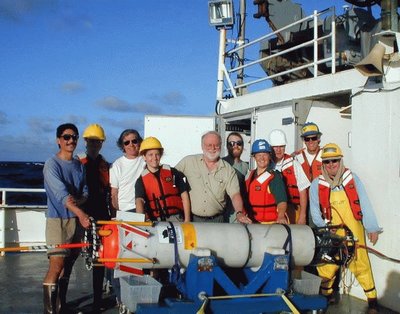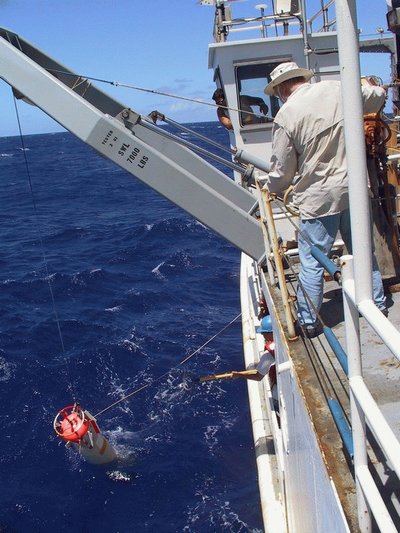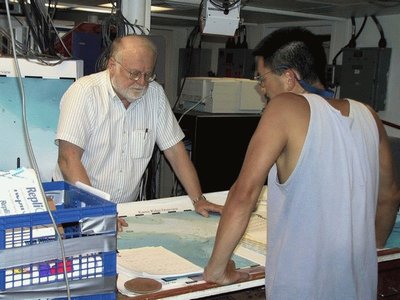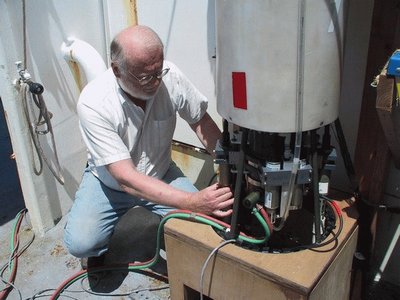November 13, 2008
Sanford’s research focuses on places that are hard to reach and forces that are difficult to measure
September is considered one of the good-weather months in Denmark Strait, between Greenland and Iceland.
Nevertheless, waves 3 feet above Tom Sanford’s head were breaking on the main deck, forcing him to the next deck up in order to launch scientific probes into the churning Nordic Sea. The exasperated captain finally convinced Sanford to suspend his work by saying, “Even the Icelandic fishermen are in port.”
It was time to concede the point, says Sanford, someone whose career has focused on places that are hard to reach and forces that are difficult to measure.
Take the waters deep in Denmark Strait. As rough as it can get at the surface, there also is a cold dense current of water below that is fast, turbulent and helps drive ocean circulation around the world.
Sanford says scientists want to monitor the current — particularly in the face of global warming — because it is part of the conveyor belt of cold, dense water from high latitudes that eventually moves warm water from the tropics north so it can cool again.
But how do you monitor a current so strong that six moorings on the sill of Denmark Strait — bearing a total of 30 current meters and 16 temperature recorders — were nearly all swept away or damaged during one attempt to measure the current? You do it using probes dropping through the water that measure the electrical field of salt water flowing through the Earth’s magnetic field. The faster the flow, the higher the voltage registered.
Sanford, a principal oceanographer with the UW’s Applied Physics Laboratory and a professor with the UW School of Oceanography, was the pioneer in developing instruments using this approach. He and his team devised numerous velocity profilers, including probes called expendable current profilers, over many decades. A profiler is so called because it makes measurements as it travels vertically through water creating a profile of the water’s characteristics.
The profilers Sanford developed were expendable in that they aren’t meant to be retrieved after being deployed. As the profiler travels down it transmits data continuously through a thin cable that connects it to a surface buoy that radios signals to a ship or aircraft. Then the profiler plows into the seabed and the connection is severed.
The expendable current profilers devised by Sanford and APL engineers Robert Drever and John Dunlap eventually led to their commercial production because of the demand from researchers, the Navy and private industry for devices able to measure how fast water is moving.
Development of this probe and other instruments, as well as the measurements he’s made using them, are reasons for two recent awards. Sanford was named a chair of oceanographic sciences by the secretary of the Navy and chief of naval operations. He will receive $1.2 million during four years to provide guidance to the Office of Naval Research, support graduate students and improve existing or build new sensors and systems based on ocean electric and magnetic fields.
The Applied Physics Laboratory is one of only four institutions nationally to have had more than one such chair — the previous one was Mike Gregg, an ocean physicist.
Sanford also received the 2008 Distinguished Technical Achievement Award given by the Oceanic Engineering Society, a part of the Institute of Electrical and Electronics Engineers. “Beyond velocity profilers, he has developed other instruments for examining vital yet difficult-to-measure oceanic characteristics,” the award citation says.
In his 40-year career, Sanford has gone on many ocean expeditions, 50 of them deep-ocean cruises, often in the North Atlantic or North Pacific.
“It is a gratifying research activity,” he says. “Being out there is really about having to deal with all the challenges that happen and there are times of palpable danger. It’s also a very human endeavor and you have to be able to work with people at all levels — from the cook, the boatswain, the chief engineer, the captain to fellow scientists.”
At this point he says he’s particularly interested in work that helps address societal problems. Hurricanes, for example, cause so much damage that even small improvements in our ability to predict their paths and intensity could save communities much suffering and money.
Instead of considering what happens in the atmosphere during hurricanes, a focus of most hurricane research, Sanford is among those looking at what happens to the ocean below the storm because that also affects a hurricane’s path and ferocity. In the mid-1980s, Sanford was the first to use P3 aircraft to drop expendable current profilers in front of hurricanes, proving the value of such deployments.
Four years ago he and Eric D’Asaro, a principal oceanographer with the Applied Physics Lab, led teams that used the so-called Hurricane Hunters of the U.S. Air Force Reserve to drop floats loaded with instruments in the path of hurricane Frances, a category 4 storm that ultimately struck Florida. The floats, programmed to travel up and down in the upper ocean without surfacing during the storm, are the most comprehensive and sophisticated oceanographic instruments ever deployed under a hurricane.
The observations of density and velocity under the intense forcing of the hurricane allowed Sanford to determine the surface waves, mixing processes and a drag coefficient, that is, the drag the ocean applies to a hurricane, drawing energy out of the atmosphere. This needs to be taken into consideration along with the temperature and mixing of water under hurricanes, according to a 2007 article published in Geophysical Research Letters with Sanford as lead author and James Girton, an oceanographer with the Applied Physics Laboratory, as third author.
The paper is not the final word in numerical modeling of these forces, he says. In fact Sanford says the Office of Naval Research and National Science Foundation project that allowed them to customize the floats was more a demonstration of the feasibility of probes that can do their jobs without having people in the area on ships.
That’s good because nobody wants to be on a ship in the midst of a category 4 or 5 hurricane.
Not even Sanford.






